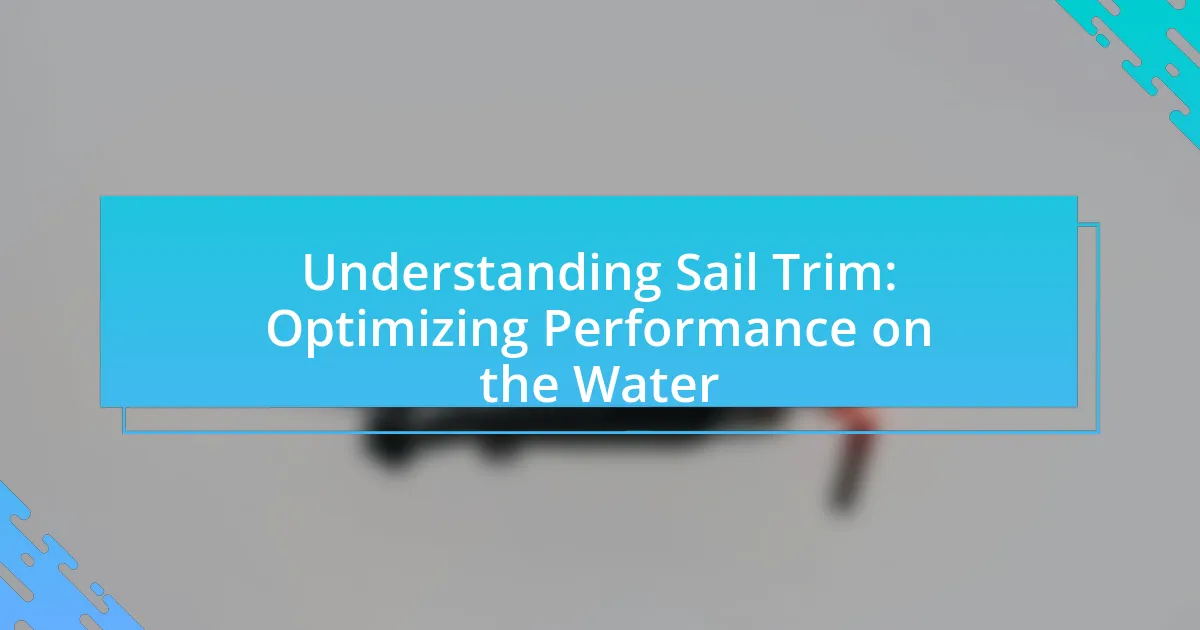The article focuses on the essential sailing maneuver known as tacking, which involves changing a sailboat’s direction by turning its bow through the wind. It outlines the mechanics of tacking, including the importance of sail adjustment, timing, and crew coordination to navigate effectively against the wind. Key principles such as wind direction, sail trim, and the role of the rudder are discussed, along with techniques for improving tacking skills and avoiding common mistakes. Additionally, the article highlights the significance of proper equipment, rigging adjustments, and the use of technology and simulators in mastering tacking for enhanced sailing efficiency.

What is Tacking in Sailing?
Tacking in sailing is a maneuver used to change the direction of a sailboat by turning the bow of the boat through the wind. This technique allows the vessel to sail against the wind by creating a zigzag course, which is essential for navigating upwind. When a sailboat tacks, the sails are adjusted to catch the wind from the opposite side, enabling the boat to continue moving forward despite the headwind. This method is crucial for effective sailing, as it maximizes the boat’s ability to progress in challenging wind conditions.
How does Tacking work in the context of sailing?
Tacking in sailing is a maneuver used to change the direction of a sailboat by turning the bow of the boat through the wind. This process involves the sails being adjusted to catch the wind from the opposite side as the boat moves into the wind, allowing it to continue sailing in a zigzag pattern when sailing upwind. During tacking, the crew typically shouts “Ready about!” to prepare for the maneuver, and once the boat is turned, the sails are trimmed to optimize performance on the new tack. This technique is essential for navigating effectively against the wind, as it allows sailors to make progress in a direction that is not directly downwind.
What are the key principles behind the Tacking maneuver?
The key principles behind the Tacking maneuver involve changing direction by turning the bow of the boat through the wind while maintaining speed and control. This maneuver requires precise timing and coordination to effectively shift the sails and adjust the rudder. Successful tacking relies on understanding wind direction, sail trim, and the boat’s balance to ensure a smooth transition without losing momentum. Proper execution of tacking enhances sailing efficiency and allows for optimal navigation against the wind.
How does wind direction influence Tacking?
Wind direction significantly influences tacking by determining the optimal angle at which a sailing vessel can maneuver against the wind. When the wind is coming from a specific direction, sailors must adjust their sails and course to effectively harness the wind’s power while maintaining speed and control. For instance, tacking into a headwind requires the boat to sail at an angle, typically between 30 to 45 degrees to the wind, allowing the vessel to zigzag towards the desired destination. This technique is essential for overcoming the wind’s resistance and is supported by the principle of lift generated by the sails, which can be maximized when the wind direction is properly accounted for.
Why is Tacking important for sailors?
Tacking is important for sailors because it allows them to navigate effectively against the wind. By changing direction through the wind, sailors can maintain speed and control while progressing toward their destination. This maneuver is essential for sailing upwind, as it enables vessels to cover distance in a zigzag pattern, optimizing their route. Historical sailing practices demonstrate that successful tacking can significantly improve a boat’s performance and efficiency, making it a fundamental skill for all sailors.
What advantages does Tacking provide in navigation?
Tacking provides several advantages in navigation, primarily enabling vessels to sail efficiently against the wind. This technique allows sailors to create a zigzag course, maximizing their ability to progress in the desired direction despite headwinds. By alternating the direction of the sailboat, tacking harnesses wind power effectively, improving speed and maneuverability. Historical sailing practices demonstrate that tacking has been essential for navigating challenging waters, allowing vessels to reach destinations that would otherwise be inaccessible due to wind conditions.
How does Tacking enhance sailing efficiency?
Tacking enhances sailing efficiency by allowing a sailboat to navigate against the wind, effectively creating a zigzag course that maximizes forward momentum. This technique enables sailors to harness wind power from various angles, ensuring that they can maintain speed and direction even when the wind is not directly behind them. By alternating the sails from one side of the boat to the other, tacking optimizes the aerodynamic shape of the sails, which can lead to improved speed and better control over the vessel’s trajectory. Historical sailing practices demonstrate that skilled tacking can significantly reduce travel time and energy expenditure, making it a crucial maneuver for competitive sailing and long-distance voyages.

What are the Techniques for Effective Tacking?
Effective tacking techniques include maintaining optimal sail trim, using proper body positioning, and timing the helm adjustments accurately. Optimal sail trim ensures that the sails are set correctly to harness wind power efficiently, which is crucial for speed and control during the maneuver. Proper body positioning helps to balance the boat and maintain stability, allowing for smoother transitions. Timing helm adjustments accurately is essential to steer the boat effectively through the wind changes, minimizing loss of speed and maintaining momentum. These techniques are supported by sailing principles that emphasize the importance of sail dynamics and boat balance in achieving successful tacking maneuvers.
How can sailors improve their Tacking skills?
Sailors can improve their tacking skills by practicing precise timing and coordination during maneuvers. Effective tacking requires sailors to anticipate wind shifts and adjust sail trim accordingly, which can be honed through regular practice in varying wind conditions. Studies show that sailors who engage in consistent practice sessions, focusing on the mechanics of tacking, can enhance their overall performance and efficiency. Additionally, analyzing video footage of their tacking techniques can provide valuable insights into areas for improvement, reinforcing the importance of self-assessment in skill development.
What are the essential steps in executing a successful Tack?
The essential steps in executing a successful tack include preparing for the maneuver, initiating the turn, and completing the tack. First, preparation involves assessing wind direction and ensuring the crew is ready for the change in direction. Next, the initiation of the tack requires turning the bow of the boat into the wind, which causes the sails to luff. Finally, completing the tack involves steering the boat through the wind and adjusting the sails to catch the wind on the new side. These steps are crucial for maintaining speed and control during the maneuver, as evidenced by sailing techniques used in competitive racing, where precision in tacking can significantly impact performance.
How does timing affect the effectiveness of Tacking?
Timing significantly affects the effectiveness of tacking by determining the optimal moment to change direction, which can enhance speed and control. When executed at the right moment, tacking allows a sailor to harness wind shifts effectively, maximizing the boat’s performance. For instance, a study by the Royal Yachting Association indicates that tacking too early or too late can lead to loss of momentum and increased drag, ultimately slowing the vessel down. Therefore, precise timing is crucial for maintaining speed and achieving efficient maneuvering during tacking.
What common mistakes should be avoided during Tacking?
Common mistakes to avoid during tacking include failing to anticipate wind shifts, which can lead to inefficient maneuvers. Additionally, neglecting to adjust sail trim promptly can result in loss of speed and control. Another mistake is not communicating effectively with the crew, causing confusion and delays. Lastly, oversteering the boat during the turn can lead to excessive heel and instability. These errors can hinder performance and compromise safety while tacking.
How can improper sail trim impact Tacking performance?
Improper sail trim negatively impacts tacking performance by causing inefficient airflow over the sails, leading to reduced speed and maneuverability. When sails are not trimmed correctly, they can create excessive drag or insufficient lift, making it difficult for the vessel to change direction effectively. Studies have shown that optimal sail trim can enhance a boat’s speed by up to 20%, while poor trim can result in a loss of control during tacks, increasing the time taken to complete the maneuver. This inefficiency can lead to a failure to maintain momentum, ultimately affecting overall sailing performance.
What are the consequences of poor timing in Tacking?
Poor timing in tacking can lead to loss of speed and control during a maneuver. When a sailor executes a tack too early or too late, the boat may not transition smoothly from one tack to another, resulting in increased drag and reduced efficiency. This can cause the vessel to lose momentum, making it difficult to maintain course and speed, which is critical in competitive sailing. Additionally, poor timing can lead to collisions with other boats or obstacles, as the vessel may not be positioned correctly to avoid them. Studies in sailing dynamics indicate that precise timing is essential for optimal performance, as even a slight delay or premature action can significantly impact the overall maneuverability and safety of the sailing experience.

What Equipment is Necessary for Successful Tacking?
Successful tacking requires a sailboat equipped with a mainsail, a headsail (such as a jib or genoa), and a reliable rigging system. The mainsail provides the primary driving force, while the headsail enhances maneuverability and speed. A well-maintained rigging system, including sheets and halyards, ensures that the sails can be adjusted effectively during the tacking process. Properly functioning winches and cleats are also essential for managing sail tension and securing lines. These components collectively enable smooth and efficient tacking, allowing sailors to navigate effectively against the wind.
How do different sail types affect Tacking performance?
Different sail types significantly influence tacking performance by affecting the boat’s speed, angle of attack, and maneuverability. For instance, a full-batten mainsail provides better shape retention and power, allowing for quicker tacks compared to a traditional loose-footed mainsail, which may lose shape and power during the maneuver. Additionally, headsails like genoas or jibs can alter the balance of the boat; a larger genoa may create more drag during tacking, slowing the process, while a smaller jib allows for faster tacking due to reduced wind resistance. Studies have shown that optimizing sail type for specific wind conditions can enhance tacking efficiency, with performance metrics indicating that boats with well-matched sail configurations can tack up to 20% faster than those with mismatched sails.
What role does the rudder play in Tacking?
The rudder is essential in tacking as it directs the boat’s movement through the water during the maneuver. When a sailor tacks, the rudder is used to change the boat’s heading, allowing it to sail into the wind and shift from one tack to another. This steering action is crucial for maintaining control and ensuring the boat can effectively navigate the wind’s direction. The effectiveness of the rudder in tacking is supported by the principle that a well-placed rudder can significantly enhance a vessel’s ability to maneuver efficiently, as evidenced by sailing techniques that emphasize precise rudder control for optimal performance.
How can rigging adjustments improve Tacking efficiency?
Rigging adjustments can significantly improve tacking efficiency by optimizing sail shape and balance. Properly tuned rigging allows for better control of the sail’s angle to the wind, which enhances lift and reduces drag during the maneuver. For instance, adjusting the tension on the halyards and sheets can help maintain the optimal sail shape, ensuring that the sails are neither too flat nor too full. This adjustment leads to a smoother transition through the tack, minimizing speed loss. Studies have shown that boats with well-tuned rigging can achieve up to 10% faster speeds during tacking maneuvers compared to those with poorly adjusted rigging.
What tools can assist in mastering Tacking?
To master tacking, sailors can utilize tools such as a sailboat with adjustable rigging, a wind meter, and a GPS navigation system. A sailboat equipped with adjustable rigging allows for optimal sail trim, which is crucial for effective tacking. A wind meter provides real-time data on wind speed and direction, enabling sailors to make informed decisions during maneuvers. Additionally, a GPS navigation system assists in tracking the boat’s course and optimizing tacking angles, enhancing overall performance. These tools collectively improve a sailor’s ability to execute tacking techniques efficiently.
How can technology enhance Tacking techniques?
Technology can enhance tacking techniques by providing advanced navigation systems and real-time data analytics. These systems, such as GPS and wind direction sensors, allow sailors to make informed decisions about their maneuvers, optimizing their angle and speed during tacking. For instance, studies have shown that using electronic navigation tools can improve a vessel’s performance by up to 20% in competitive sailing scenarios. Additionally, software applications that analyze wind patterns and boat performance can help sailors refine their tacking strategies, leading to more efficient and smoother maneuvers.
What are the benefits of using sailing simulators for practice?
Sailing simulators provide several benefits for practice, including enhanced skill development, risk-free learning environments, and immediate feedback. These simulators allow sailors to practice maneuvers like tacking without the dangers associated with real-life sailing, enabling them to experiment with techniques and strategies in various weather conditions. Research indicates that using simulators can improve decision-making skills and situational awareness, as sailors can repeatedly practice scenarios that they may encounter on the water. Additionally, simulators often include performance metrics, allowing users to track their progress and refine their techniques effectively.
What are the Best Practices for Smooth Maneuvering while Tacking?
The best practices for smooth maneuvering while tacking include maintaining proper sail trim, anticipating wind shifts, and executing coordinated movements. Proper sail trim ensures that the sails are adjusted to maximize efficiency and minimize drag, which is crucial during the transition of tacking. Anticipating wind shifts allows sailors to prepare for changes in wind direction, enabling a smoother turn. Coordinated movements, such as timing the helm and crew actions, help maintain balance and control throughout the maneuver. These practices are supported by sailing techniques that emphasize the importance of communication and teamwork among crew members, which enhances overall performance during tacking.
How can sailors maintain balance during a Tack?
Sailors can maintain balance during a tack by shifting their weight appropriately and adjusting the sail trim. Weight should be moved to the windward side as the boat turns to counteract the heeling effect caused by wind pressure on the sails. Additionally, adjusting the sails to ensure they are properly trimmed helps to maintain optimal speed and stability. This technique is supported by the principle of balance in sailing, where the distribution of weight and sail configuration directly influences the boat’s performance during maneuvers.
What tips can help in achieving a seamless transition during Tacking?
To achieve a seamless transition during tacking, sailors should focus on timing, communication, and body positioning. Proper timing ensures that the maneuver is executed when the wind is optimal, allowing for a smooth change in direction. Effective communication among crew members is crucial to coordinate actions, such as when to release and trim sails. Additionally, maintaining proper body positioning helps to balance the boat and prevent excessive heeling, which can disrupt the transition. These practices are supported by sailing experts who emphasize that synchronized movements and awareness of wind shifts significantly enhance the efficiency of tacking maneuvers.

















